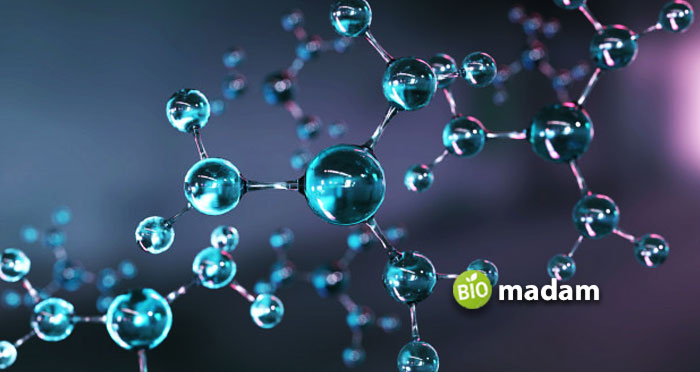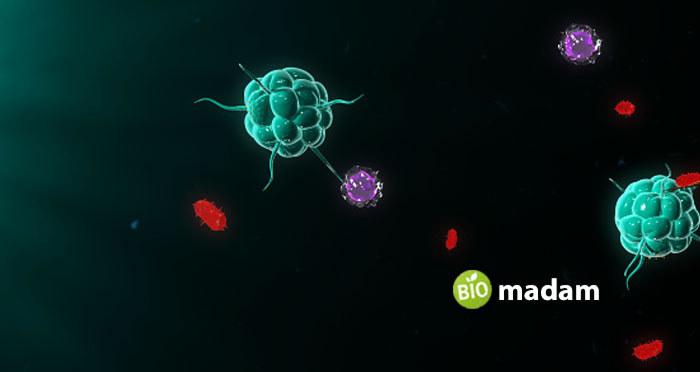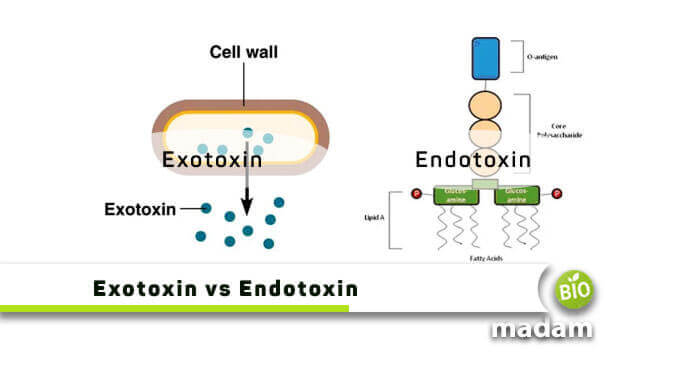Recently updated on March 5th, 2024 at 06:04 am
Endotoxin is a type of toxic substance or pyrogen released through bacteria located inside the bacterial cell. These are also components of the cell walls of gram-negative bacteria. The most common examples of gram-negative bacteria include E. coli and K. pneumonia, whereas endotoxins have pertussis, cholera, etc.
Exotoxins are bacterial toxins either secreted by the bacteria or released upon their death, similar to endotoxins. They cause significant damage to the host cells either by disrupting cellular homeostasis or destroying high-potency cells. For example, cholera is an exotoxin produced by the bacteria V. cholerae.
Comparison Table
| Factors | Endotoxins | Exotoxins |
| Cellular Location | Bacterial cell wall | Secretion from within the bacterial cell |
| Immune Reactions | Fever, distress, & sometimes death | Swelling, rashes on the skin, and fever |
| Host Immune Target Cells | Granulocytes, macrophages, endothelial cells | Somatic cells |
| Composition | Carbohydrates | Proteins and polypeptides |
| Temperature Resistance | Greater | Lesser |
| Fever Induction | Yes | Lesser extent |
| Molecular Weights | >100 kDa | 50 – 1000 kDa |
| Denaturation | Resistant | Prone |
| Strain Specificity | Gram-negative bacteria | Gram-positive & negative bacteria |
| Antigenicity | Yes | Yes |
| Conversion to Toxoids | No | Yes |
Cellular Location
Endotoxin
Endotoxins, as already mentioned, are found as integral components of the outer cell walls of gram-negative bacteria. These cell walls cover the cell membranes and help provide them an extra covering, advantageous to combat and survive harsh environments.
Exotoxin
Exotoxins are mostly proteins or polypeptides. As is evident from their proteinaceous nature, they must be synthesized inside the bacterial cell and then secreted to perform their toxic reactions. Moreover, most of them act on locations or tissues far away from the site of bacterial invasion, which necessitates their secretion and travels through the bloodstream to their respective sites of action.
Immune Reactions
Endotoxin
Lipopolysaccharide in such components is responsible for evoking the host organism’s immune response. It is also associated with inciting septic shock in animals. After endotoxins are released in the body, the sequence of events includes fever, physiological distress, and severe reactions; death can also happen. Moreover, the three types of cells through which endotoxins incite immune response are granulocytes, macrophages, and endothelial cells.
Exotoxin
The significant targets of host cells through which exotoxins incite an immune response are somatic cells. The exotoxins directly bind with different antibodies presented on the surfaces of these somatic cells. Their binding with the antibody-presenting cells also prevents invasion inside the host cells. In this way, exotoxins also behave as antigens. By binding with the antibodies and forming an antigen-antibody complex, these cells are targeted for destruction by the host immune response.
Exotoxins can act in other ways by clamping with the exotoxin-specific receptors present on the host cell surface. By this, protein synthesis is inhibited, and cell death necrosis occurs. Moreover, the host responses can include swelling, redness, and fever in most common cases.
Chemical Composition

Endotoxin
It is a heteropolymer of LPS divided into three constituent elements: lipid-A, core-oligosaccharides, and Antigen-O. Lipid-A makes the core oligosaccharide of the LPS, whereas an O-antigen is an O-specific oligosaccharide. Further dissection shows that lipid A is typically composed of two glucosamine units attached with beta linkage and linked acyl groups. On the other hand, Antigen-O is made up of repeating units of 3-5 sugars, with individual chains having lengths of up to 40 repeating units.
Exotoxin
These are most often proteins and polypeptides. These can be further divided into subunits, most commonly A and B. In such cases, B subunits act as receptors that help facilitate the binding of the toxin to the host cell while making way for subunit A to be released into the cytoplasm.
Temperature Sensitivity
Endotoxin
Endotoxins show high and strong resistance against heat inactivation treatments. If dry heat is used, it requires 30 minutes of 250° Celsius for their inactivation. But studies have shown that hydrothermal processing destroys endotoxins at just 130° Celsius or 266° Fahrenheit for 60 minutes.
Exotoxin
Since exotoxins are primarily proteins and polypeptides, they require fewer temperatures for their denaturation. Also, since most of these work on body temperatures of 37 degrees Celsius, these are often entirely denatured on temperatures above 40 degrees Celsius.
Molecular Weights Range
Endotoxin
Also known as lipoglycans, LPS molecules are large. Due to their large sizes, they also are high molecular weight compounds. Typical molecular weights of endotoxins are greater than >100,000 Daltons.
Exotoxin
Since exotoxins are mostly proteins or polypeptide molecules, their weights fall in the typical ranges of proteins and polypeptides. For example, most of the exotoxins range in their molecular weights from 50,000 – 1,000,000 Daltons.
Denaturing Properties
Endotoxin
Since endotoxins are large carbohydrate molecules and show considerable temperature tolerance to denaturation, they are more stable. Since endotoxins are large carbohydrate molecules and show considerable temperature tolerance to denaturation, they are more stable. Also, the temperatures at which exotoxins denature would not usually work for endotoxins because of their requirements of high temperatures for that.
Exotoxin
Due to their proteinaceous nature, they are more prone to denaturing at slightly high temperatures than physiological temperatures. Also, various denaturing agents, the most common example of which is a detergent, effectively denature exotoxins since they function to disrupt the levels of protein structure, thus denaturing them.
Strain Specificity
Endotoxin
Since endotoxins are integral components of gram-negative bacteria’s cell walls, they are associated with them only.
Exotoxin
As exotoxins are secreted toxins, they are not specified with any bacterial strain and can be associated with any bacteria secreting them. These can include both gram-positive and gram-negative bacteria.
Antigenicity

Endotoxin
An antigenic substance is a toxic substance that can incite an immune/antigenic response in the host organism. Endotoxins are such a compound capable of creating an antigenic response in the host. Still, they are not converted into toxoids, inactivated substances that can be used as vaccines like (Tuberculosis, Influenza, Herpes, Tetanus, and many more).
Exotoxin
Similar to endotoxins, exotoxins are also capable of inciting the immune response of the host. But since they are natural proteins, their denatured or inactivated forms are usually made into toxoids which can then be used as vaccines.
Conclusion
Both endotoxins and exotoxins will still remain harmful substances, despite having prominent differences among them. Endotoxins usually stay outside the pathogenic bacteria that can weaken a host’s immunity. On the contrary, exotoxins are proteins that naturally show antigenicity and are dangerously toxic.

Hello, I would like to introduce myself to you! I am Chelsea Rogers, an experienced blog writer for science articles, holding an MPhil degree. My enthusiasm to grab the best knowledge, let it relate to botany, zoology, or any other science branch. Read my articles & let me wait for your words s in the comment section.

